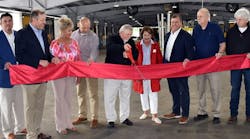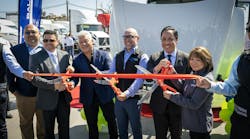The relationship between fleets and dealers is reaching a new, more productive era.
The uneasy truce -- some would call it friction -- that used to govern the interaction between fleets and truck dealers has given way to a new era in which both sides are working toward the same goal.
Functions such as ordering new equipment, administering warranty, turning wrenches, stocking parts, and trading used rolling stock are increasingly viewed by fleet owners as incidental to the business of hauling freight.
Dealers, having moved beyond their traditional reliance on new-vehicle sales, are only too happy to respond.
Jim Westlake, director of the American Truck Dealers (ATD), traces that conversion back to the beginning of the decade, when new truck sales fell from grace. "Dealers learned that margins on new equipment were no way to make a living," he says. "They needed to go after opportunities such as financing, insurance, leasing, service, parts, and used trucks to eke out a living."
Go after it they did. Dealers today offer a wide spectrum of services attractive to fleets.
"We view our dealer as a consultant in running our fleet," says Brad Bedsau, vice president and owner of BCB Trucking in Sparta, N.C. "The relationship must be based on good communication. When that starts to break down you run into problems."
That's a responsibility Bart Warner, principal of Freightliner of Utah in West Valley, takes seriously. "Everyone in the dealership must take a holistic view," he says. "We have to understand our customers' business."
The increased level of expectation is helping drive the consolidation of truck dealers. ATD figures show that the number of dealers is shrinking, while the number of dealer locations, or rooftops, is growing (see chart below).
"The chief reason dealers are consolidating is to spread their administrative costs over multiple facilities," says Martin Labbe, principal of Martin Labbe Assoc., an industry consulting firm.
With growing demands for dealers to do more, the supply of service facilities is stretched to the limit. "A lot of dealers are going flat out and turning away work," says Labbe.
That helps explain why many dealers have moved to 24-hour service and are looking at taking over fleet shops. "That allows the dealer to get the best use of a scarce resource -- the maintenance bay," Labbe says.
A shortage of maintenance bays is compounded by a shortage of people working in them. According to ATD's Westlake, "This shortage of qualified technicians is expected to become more acute. If dealers are going to continue to attract fleet customers, they're going to have to be prepared to get technicians in-house and up to snuff."
Although more fleet maintenance is gravitating to dealers, they still find it hard to recoup the huge investment they've made in bricks and mortar, diagnostic equipment, and technicians.
They will come For those who compete in the new market reality, the risks and the opportunities are great. When Freightliner dealer Bart Warner opened his dealership five years ago, he recognized the trend of fleets outsourcing maintenance. Realizing the scope of the business potential, Warner scrapped plans for a 20-acre lot and built a 150-acre facility that boasts 200,000 sq. ft. under one roof, 100 service bays, and some 50 acres of paved parking. Warner also offers a trailer dealership, reefer center, truck wash, tire center, fueling system, and a scale.
Warner has a staff of 200, including 53 technicians and 15 additional body technicians. Business is growing so fast that he anticipates adding another 20 techs by year's end.
More important than Warner's sheer bulk is his attitude toward customers. While waiting for trucks to be serviced, customers can shoot pool, take a shower, or even do their laundry.
That customer service mandate finds expression in the road tests conducted after any major tractor repair. True, Warner has a dynamometer. But that's not enough. He has rigged up a trailer loaded with 50 barrels of gravel, which he hooks to the tractor in question for a bit of real-world testing. "Yeah, it costs me an extra $50, but what's the big deal?" The big deal is that not everybody goes to such lengths to please the customer.
Another key to Warner's success is location. It doesn't hurt that major carriers like Pride Transport Inc., Dick Simon Trucking, and C.R. England -- all current customers -- are within a stone's throw of the dealership.
Spec'ing the truck Location, or lack thereof, governs BCB Trucking's relationship with its dealer, Carolina Kenworth. Even though the dealer has locations in Charlotte, Greensboro, and Hickory, N.C., none is closer than 100 miles to the fleet. While that limits the service work, there are still a growing number of touch points.
BCB is a longhaul LTL carrier running textiles and other general commodities in time-sensitive coast-to-coast movements. The fleet sells three-day service to Los Angeles from its home base in North Carolina; the team units average 41/2-day turns to the West Coast.
To do that, BCB depends on a fleet of 31 trucks and 67 trailers. Of that fleet, 16 trailers are dropped at customer locations for loading, while 9 power units fan out across the Southeast to feed the network. Loads are subsequently consolidated in BCB's Sparta warehouse.
In doing so, they rack up the mileage -- 275,000 in the course of a typical year. With those kinds of numbers, Bedsau is trading equipment every two years.
"We depend on them to help spec units that give us the best fuel mileage," he says. To accomplish that, the Kenworth dealer involves all component manufacturers in a team effort to unlock the greatest fuel efficiency by spec'ing the right engine size, gear ratio, weight, tire size, and rear differential. The dealer also fights for and wins concessions from component suppliers.
Managing parts Bedsau also depends on the dealers to manage his parts inventory. He has a consignment arrangement with a Caterpillar dealer located 100 miles away in Charlotte. The Kenworth dealer delivers twice a week; these runs can be supplemented with BCB's own units that run through the city daily.
For Jim Palmer, president of Jim Palmer Trucking, a 350-unit refrigerated fleet, access to truck dealers is not a problem. In fact, there are seven such supplier locations from which to choose in his home base of Missoula, Mont.
Missoula is such a small town that Palmer tends to hang around in the same circles as his dealer friends. That enforces an informal code of conduct and expectations.
His fleet order for 1998 reflects the way Palmer does business. This year, he'll add 90 new units -- 70 Freightliners, 10 Kenworths, and 10 Peterbilts -- to give business to the dealers with whom he currently has strong ties. "I share my expectations with these guys and they help build a truck that will meet my needs and still provide some residual value" at the end of its 42-48 month service life.
Palmer, too, relies on his dealers to lower his parts inventory. As recently as three years ago, he carried $70,000 worth of parts in his fleet shop. Because he has turned more of that responsibility over to one of the seven supplier dealers located in Missoula, that inventory now runs about $12,000. Still, Palmer can get a part within about 10 minutes, faster than the time it took to retrieve it when he had it in stock.
Without the parts inventory, Palmer has converted his old parts room into a lunch and break room for his technicians.
More and more fleets are following Palmer's tracks. According to Martin Labbe, the OE share of the parts market is up 9% over last year. "With 60,000 to 80,000 parts numbers out there, it's hard for fleets to keep track of all of them," says Terry Young of Carolina Volvo GMC.
While Palmer's company is growing at a 10-15% clip, "we're not growing our shop," he says. His two shops -- one in Missoula and one in Salinas, Kan. -- handle light PM work, including electric and reefer work. All engine and transmission work is farmed out. He has 13 technicians, down one-third from just five years ago.
But even then there are no hard and fast rules. Rather than have a truck wait at his own shop for service, he'll send it down the road to a dealer.
Getting even closer to the dealer is TMC Transportation, a 1,000-unit flatbed operation out of Des Moines. "We have to get out of our little pond," says TMC president Tim Annett. "That means looking at things a different way." And that means a closer relationship with the dealer.
Five years ago, that relationship was dysfunctional, at best. "It was always a confrontational situation when we would sit down with our dealer to establish trade values," he recalls.
A switch in dealers and the acquisition of two truckload carriers in Indiana opened up new possibilities. "We look at the purchasing decision as one in which we're borrowing the trucks for a certain amount of time," Annett says. "The dealer has to tell us what they want on it."
Today there are more dealer personnel within the TMC operation. "We have dealer personnel on staff to make sure warranty and service is done." That dealer complement will double in the next 18 months. TMC sister operations Shamrock Transportation and Dakota Transportation Systems completely outsource their maintenance.
"This relationship is not about price," says Annett. "It's about improving the cost of our operation. To use a trucking metaphor, it allows us to look out the windshield instead of at the dashboard."
Doing more When it's not convenient for the fleet to go to the dealer, the dealer goes to the fleet to provide service. Terry Young plans to double his two-truck mobile service fleet by the end of the year.
Some fleets carry this dealer relationship further. Jerry Heavener was president of Guy Heavener Inc., a 30-unit family business that specialized in the transportation of bulk construction aggregates, sandstone, and highway salt.
"The family wanted to go off in different directions," says Heavener. "The bulk business wasn't as profitable as it could be." Heavener opted to sell the 30-unit fleet that his grandfather started to Don Metzger, his local Kenworth dealer. Metzger seized the opportunity to test some of his equipment theories in the real world. Today, Heavener works as a sales representative for Metzger.
No silver bullet Melton Truck Lines, Tulsa, Okla., converted to dealer service to help it through a 1992 merger that tripled the size of the fleet overnight. Today, the company runs 410 power units and 750 trailers.
"We had struggled to find a capable manager, and our systems were poor," says president Robert Peterson. "Outsourcing our maintenance to the dealer brought us a good manager and a decent system. But it's no silver bullet. People looking for incredible savings will be disappointed."
Looking back, Peterson would do nothing different. "You obviously lose some objectivity when it comes to evaluating other manufacturers' equipment," he says. "But the decision to outsource for us was the right decision at that time."
There are no right answers in this dynamic marketplace. Fleet needs and their relationships with dealers are constantly evolving. But increasingly, what fleets need and what dealers have to offer are on common ground.
To combat the capacity shortage in truck maintenance facilities, Freightliner Corp. has unveiled CapAd 2000, a capital financing program developed for financing major dealer service facilities and enhancement projects, including expansion of current facilities and the construction or rehabilitation of satellite service locations. The $300-million fund was created in conjunction with Mercedes-Benz Credit Corp.
CapAd 2000 will offer up to 100% financing of approved construction projects totaling $1 million or more, at a rate set at Prime minus 11/4%, and with payments based on a 20-year amortization. Dealers can choose either a floating rate or a rate fixed for a period of five years. While other financing programs are available to help with the purchase of new dealership operations, CapAd 2000 is available exclusively for purchases or renovations that include additional service facilities. That, explained Freightliner president and CEO Jim Hebe, is where customers and dealers are expressing the most acute need.


